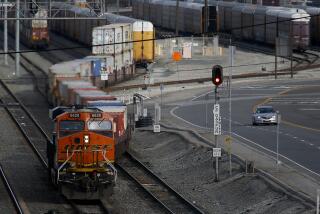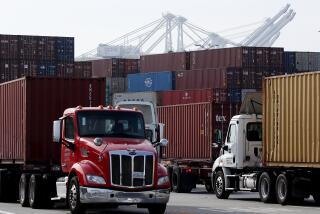Aging U.S. School Buses Still Fouling Air
Aging school buses continue to spew harmful diesel across the United States, a new report based on federal and state data says, and major funding is needed to address the problem.
The report, released Wednesday by the Union of Concerned Scientists in Berkeley, found that the nation’s 505,000 school buses were some of the oldest and dirtiest vehicles on the road. More than a third have been in use for more than a decade, and a single bus can produce between twice and 10 times as much diesel soot as a big rig.
For the record:
12:00 a.m. May 31, 2006 For The Record
Los Angeles Times Wednesday May 31, 2006 Home Edition Main News Part A Page 2 National Desk 1 inches; 41 words Type of Material: Correction
School bus emissions: An article in Thursday’s Section A said studies reportedly showed that large amounts of soot could accumulate inside aging school buses from open crankshafts. The studies reportedly showed that soot can accumulate inside buses from open crankshaft cases.
Although school buses have become safer to ride because of safety belts and other improvements, the authors and other experts said related studies were showing large amounts of soot could accumulate inside the buses from open crankshafts.
About 95% of the nation’s school bus fleet is powered by diesel, and high levels of diesel exhaust and soot expose children to higher risk of asthma, cancer and other significant health problems, the report said.
California leads the nation in regulatory efforts and funds to replace aging buses, the study said, but still has made limited progress. State cleanup programs reduced school bus soot by less than 9% from 1999 to 2005, the report said. Less than 10% of California’s fleet is retrofitted with sophisticated soot-traps, and less than 5% is powered by cleaner natural gas.
“Even if you have a very good program, kids are still riding on very high-polluting buses,” said lead author Patricia Monahan, a former air pollution and toxics scientist with the U.S. Environmental Protection Agency.
The picture is worse nationally. Action on federal, state and local levels has reduced average soot emissions by about 2% in recent years, the study said. The EPA has $6 million allocated for school bus cleanup this year. The House of Representatives recently earmarked $28 million for a variety of diesel cleanup programs, including for school buses; the Senate has yet to act.
A new bus costs between $100,000 and $130,000. Some buses built after 1994 can be retrofitted with a diesel trap for about $7,500.
Experts estimated that $16 billion would be needed to retrofit or replace more than half a million school buses in the U.S., including $715 million for California. “That’s a huge amount of money ... but we think kids deserve to ride on clean buses,” Monahan said. “The state and federal government really need to step in. Cash-strapped local school districts should not have to choose between books and buses.”
A request for $215 million to clean up or replace school buses has been placed before California voters as part of a $20-billion transportation bond measure on the November ballot. The state Legislature allocated $25 million this year for retrofitting or replacing buses, and vehicle fees bring in additional funds.
Districts in the Central Valley, rural desert areas, Fontana, Downey, Lake Arrowhead, Huntington Beach and elsewhere still have older, polluting buses, according to state air board data. Fontana has eight buses built between 1959 and 1969 still on the road, and a ninth built before 1977.
Mary Stevens, transportation director for Fontana schools, said older buses built by a now-defunct bus manufacturer -- nicknamed “Twinkies” because of their round, yellow shape -- were still used to help transport 11,000 pupils daily because they were extremely durable. But she said the district was “very excited” because the South Coast Air Quality Management District was due to vote next week to approve funds to replace the oldest buses with new, natural gas models and to provide a fueling station.
AQMD staffers said the board was expected to approve $1.7 million to replace the eight oldest buses and build the fuel station. Funds also are expected for seven buses in other area districts.
In 2001, the AQMD passed the first regulation in the nation requiring school districts to replace fleets with cleaner-burning natural gas buses, provided that funds were available. The AQMD has allocated $55.7 million to the program so far, with the money coming from state budget funds, polluter penalties and vehicle registration fees.
More to Read
Sign up for Essential California
The most important California stories and recommendations in your inbox every morning.
You may occasionally receive promotional content from the Los Angeles Times.










